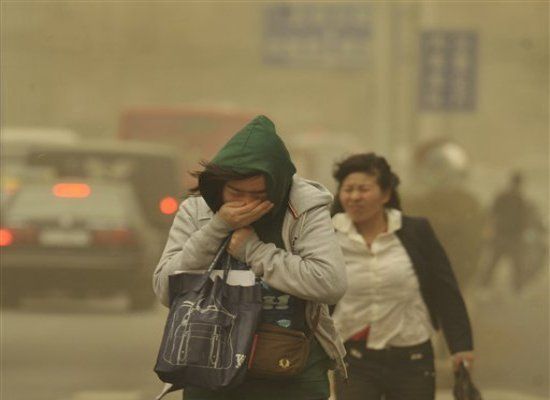 I was in Boston during the enormous Beijing sandstorms a week ago, but I’m still seeing its effects in my clinic. People are still coming in with severe coughing, bronchitis and pneumonia, and many are proving unusually hard to treat. What happened to make this so severe? And is there any way to avoid the near-certain sandstorms that are predicted for the next two months?
I was in Boston during the enormous Beijing sandstorms a week ago, but I’m still seeing its effects in my clinic. People are still coming in with severe coughing, bronchitis and pneumonia, and many are proving unusually hard to treat. What happened to make this so severe? And is there any way to avoid the near-certain sandstorms that are predicted for the next two months?
I think the best way to think of a sandstorm is as a dramatic and immediate demonstration of my favorite topic — air pollution. Sand fits the pollutant category of particulate matter; most of the particles are big, and they simply stick in your nose and upper bronchi, giving people serious coughing and irritation, but nothing more dangerous. But a lot of sand is much smaller, under the PM2.5 micrometer size that is shown to be small enough to get deep into your lungs. It’s these smaller particles that cause the inflammation cascades that are causing major illness, especially in small children, asthmatics, and the elderly with lung disease. These super-bad days cause a big spike in clinic and hospital visits with all types of respiratory illness, as well as heart attacks.
What can you do to prevent problems? The #1 tip, as all the Beijing news outlets made very clear, is to not go outside on the worst days. That last sandstorm tipped the scales of the Air Quality Index all over eastern China, and Hong Kong set a record with an AQI over 500. That’s far above the 200 or 300 that would be considered an environmental emergency (healthy is under 20-50 AQI). So, if you must go outside, wearing a mask will help a lot — especially those N95 masks that I’ve mentioned before and are available at places like April Gourmet and Jenny Lou’s, as well as clinics and pharmacists. And schools should continue their normal air pollution action plans, by following the US Embassy’s Beijingair website and stopping outdoor activity per their normal protocol. (All schools have a protocol by now, yes?)
A Little Perspective, Please
Please allow me to get on the soapbox a bit; I’m certainly glad that there was a lot of media attention for those dangerous days. But let’s not forget that during the rest of the year in Beijing there are many days when the US Embassy’s AQI is over 300-500, and I’m not aware of any major public or media campaigns to warn people on those “normal” severe pollution days. Sandstorms make for dramatic news items and pretty pictures on CNN International, but an AQI of 500 on a “normal” pollution day causes exactly the same health risks as a sandstorm AQI 0f 500. We’re so used to terrible pollution days here in Beijing that I fear we are dangerously lax to its effects. Right now, the US Embassy’s AQI is 321 and today’s max is 411, which are all at emergency levels, and yet I see nothing in any media about this. Beijingers’ health would be far better protected if there were more urgent media messages and prevention strategies in place for all times of the year.
Follow me on Facebook: @BainbridgeBabaDoc
Photography: www.richardsaintcyr.com
You are right about the fine particles, Richard. "Sandstorm" isn't really the right word for it, it's mostly fine clay (loess) from North China … the soil from some poor farmer's land who neglected to plant trees. The good news is that once these storms are over it settles out fairly quickly because this kind of dust is heavy. Unfortunately the same is not true of the diesel exhaust and coal burning soot that we all live with on a daily basis…
If the lung problems are persistent, and present as lingering bronchitis or bronchiolitis infection, try ruling out MYCOPLASMA infection. I never even heard of mycoplasma before I got my diagnosis!
I had mycoplasma lung infections early spring 2007, and just a few months ago (Winter, 2010) as well. Hard to discover, but a sharp woman doc at BJU had a hunch, ordered a simple blood test and found my problem which had not responded to previous antibiotics.
When again I had similar symptoms this winter, I went to several doctors, who dismissed that it might be mycoplasma. I finally went back to Dr. Li Jia at BJU….who once again confirmed that it was no regular infection, it was mycoplasma ( must order a special blood test, the test is not available at some clinics, and, at BJU at least, takes an extra day to get results).
Liora
Yes, mycoplasma is one of the more common “atypical” bugs. Since there isn’t a great test for it, that’s why most doctors will give an antibiotic like Azithromycin or Levofloxacin — both of which are very effective for this, and most, bugs causing respiratory infections. I’m a big fan of azithromycin for that lingering cough bronchitis-type patient…